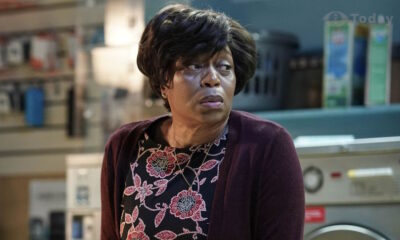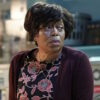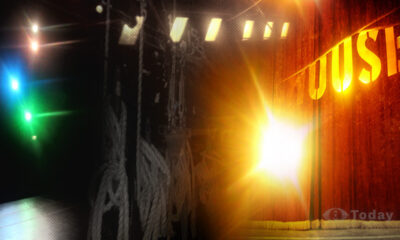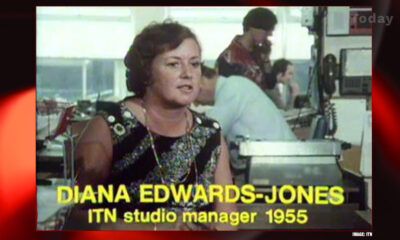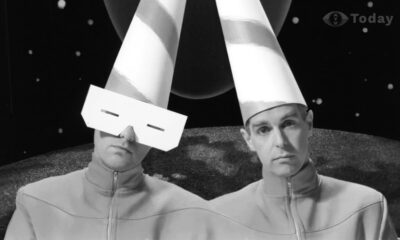Flashback: House of Eliott
 The fashion based period drama series from the creators of Upstairs, Downstairs. The BBC drama ran for three seasons in the 1990’s and starred Stella Gonet and Louise Lombard who decide to set up their own fashion house but find the competitive world of fashion has perils of its own. The two sisters must battle competitors, scandals and strikes to achieve their dreams.
The fashion based period drama series from the creators of Upstairs, Downstairs. The BBC drama ran for three seasons in the 1990’s and starred Stella Gonet and Louise Lombard who decide to set up their own fashion house but find the competitive world of fashion has perils of its own. The two sisters must battle competitors, scandals and strikes to achieve their dreams.
Actresses Jean Marsh and Eileen Atkins had created the initial concept that went on to become the  hugely popular LWT series Upstairs, Downstairs. Jean Marsh played Rose in all five seasons of the period drama and while Eileen Atkins was originally to play the part of troublesome Sarah the role eventually went to actress Pauline Collins as Atkins found work elsewhere. Years later the two actresses would once again come up with an idea for another drama series this time set in the 1920s – a drama revolving around two sisters who start up their own fashion house. With the success of Upstairs, Downstairs behind them it’s not surprising the BBC gave the series the go ahead.
hugely popular LWT series Upstairs, Downstairs. Jean Marsh played Rose in all five seasons of the period drama and while Eileen Atkins was originally to play the part of troublesome Sarah the role eventually went to actress Pauline Collins as Atkins found work elsewhere. Years later the two actresses would once again come up with an idea for another drama series this time set in the 1920s – a drama revolving around two sisters who start up their own fashion house. With the success of Upstairs, Downstairs behind them it’s not surprising the BBC gave the series the go ahead.
The series aired on BBC One for three seasons between 1991 and 1994 and starred Stella Gonet and Louise Lombard as the two leading characters – the Eliott sisters. With the death of their father the duo decide to put their inheritance to good use and start their own fashion house – after all but sisters have talents in designing and creating dresses. However, along the way the two sisters would have to overcome many hurdles such as deceiving family members, scandals, devious competitors and strikes. To begin with their father leaves them practically nothing in their will and the little that is left from their estate is withheld from them by their uncle Arthur [Peter Birch] who feels they can’t be trusted with the money. Just as the two are getting established a major scandal involving Arthur and drugs smuggling threatens to bring down their business just as its getting started. The scandal was one of just several that threatened to destroy the business over the course of the three seasons.
The series was set in the 1920s and dealt with the post-war generation who wanted to forget the horrors of the battlefield and enjoy themselves. The fifth season of Upstairs, Downstairs had also dealt with this as it too was set in the same period. The character of Georgina Worsley [Lesley-Anne Down], who had served as a nurse in the war, throws herself into the party scene of the 1920s. As the two dramas were set in the same era and were created by the same people it was one of many  themes that the two covered. The Great Strike of 1926 was also covered in both dramas as was the rise of cinema in Upstairs, Downstairs the character of Ruby [Jenny Tomasin] was used to charter the popularity of the new medium in the young while Georgina Worlsey becomes – ever so briefly – an actress. In The House of Eliott the character of Jack Maddox [Aden Gillet] sets up his own film company and the two sisters design costumers for his films at various points. The theme of social divide and class barriers are also covered and the poverty of the poor is also a plot point in both shows. In Upstairs, Downstairs Elizabeth Bellamy [Nicola Pagett] helps out at soup kitchens and tries to fight against the poverty and also fight for women’s rights – she becomes a suffragette. Evie [Louise Lombard] takes on a similar role in the early episodes of House of Eliott when she visits the poor regions and meet’s Jack’s campaign sister Penelope [Francesca Folan]. Penelope is a combination of the Elizabeth and Henrietta characters [Jenifer Armitage] in Upstairs, Downstairs. Both dramas also have Fabian characters but these sharing of themes aren’t surprising given the fact that both are set in a similar period and are natural topics for any drama set in the era to cover.
themes that the two covered. The Great Strike of 1926 was also covered in both dramas as was the rise of cinema in Upstairs, Downstairs the character of Ruby [Jenny Tomasin] was used to charter the popularity of the new medium in the young while Georgina Worlsey becomes – ever so briefly – an actress. In The House of Eliott the character of Jack Maddox [Aden Gillet] sets up his own film company and the two sisters design costumers for his films at various points. The theme of social divide and class barriers are also covered and the poverty of the poor is also a plot point in both shows. In Upstairs, Downstairs Elizabeth Bellamy [Nicola Pagett] helps out at soup kitchens and tries to fight against the poverty and also fight for women’s rights – she becomes a suffragette. Evie [Louise Lombard] takes on a similar role in the early episodes of House of Eliott when she visits the poor regions and meet’s Jack’s campaign sister Penelope [Francesca Folan]. Penelope is a combination of the Elizabeth and Henrietta characters [Jenifer Armitage] in Upstairs, Downstairs. Both dramas also have Fabian characters but these sharing of themes aren’t surprising given the fact that both are set in a similar period and are natural topics for any drama set in the era to cover.
While the characters of Evie [Louise Lombard] and Beatrice [Stella Gonet] where the two main stars of the series there were, of course, other characters that featured within the series and had their own stories. As previously mentioned there was Jack [Aden Gillet] who set up his own film company and married Beatrice in season two. Penelope Maddox [Jenifer Armitage] bowed out after the first season as did Arthur [Peter Birch] and Lady Lydia Eliott [Barbara Jefford]. Working with the two sisters in their business from the very beginning was the faithful Tilly [Cathy Murphy] and other workers for the sisters included Agnes [Victoria Alcock], Madge [Judy Flynn] and Betty [Diana Rayworth]. Appearing in the first season and part of the second was banker Sir Desmond Gillespie [David De Keyser] who is killed off early in the second season by the corrupt Ralph Saroyan [Michael Culver].
Behind the scenes and actresses Eileen Atkins and Jean Marsh were very much involved with the series contributing towards scripts. Writer Jill Hyem who had written for Tenko, Campion, Wish Me  Luck, Howard’s Way and the 1985 Tenko reunion movie wrote two scripts for the first series of the drama. Deborah Cook was another writer for the series who has since contribute scripts for EastEnders, The Royal, Peak Practice and Casualty and directors included Graeme Harper who has directed for a wide range of programmes such as Doctor Who, The Bill, Boon and many other dramas. Filming for the drama took place at the BBC Television Centre and is believed to be one of the last major dramas filmed there. Television Centre now tends to house just entertainment shows instead of big dramas. Location filming, for the street where the fashion house was located, was done in Bristol.
Luck, Howard’s Way and the 1985 Tenko reunion movie wrote two scripts for the first series of the drama. Deborah Cook was another writer for the series who has since contribute scripts for EastEnders, The Royal, Peak Practice and Casualty and directors included Graeme Harper who has directed for a wide range of programmes such as Doctor Who, The Bill, Boon and many other dramas. Filming for the drama took place at the BBC Television Centre and is believed to be one of the last major dramas filmed there. Television Centre now tends to house just entertainment shows instead of big dramas. Location filming, for the street where the fashion house was located, was done in Bristol.
The style of the series is very much outdated to modern audiences and there is no clear indication of the passage of time. Within a single episode months could pass and yet there’s no real evidence off this on-screen bar events said to be weeks away suddenly happening. Nowadays dramas follow a far more linear narrative in single episodes with events taking place over a short period of time. The filming technique on the series is also vastly outdated by modern standards and even by dramas of the time. As the industry moved into the 1990’s production techniques on dramas changed as technology  improved filming processes and drove forward progress. The House of Eliott was filmed in a multi-camera set up on and video however by this time producers on drama preferred to shoot with film and on a single camera set up. Using film instead of video gave productions a cinematic quality to the picture and shooting with just one camera helped productions plans shots more carefully and gave them a completely different feel and stylistic feel. It gave producers to the chance to try all kinds of different shots as they only had to set up one camera instead of using three or four. Using a single camera also meant each scene could be broken down into a series of single shots with each segment filmed separately instead of a director having to cut between different cameras to get the shots he wanted. In many ways it meant the pace of stories could be quickened as the drama could cut very quickly between different shots in fast succession rather than the slowly process of cutting between different cameras and the actors slowing down their lines or acting to allow for this. Another plus of using single cameras meant the blocking of scenes could remove the theatrical feel many had with actors all standing in a line to allow the cameras to cut between them quicker and easier.
improved filming processes and drove forward progress. The House of Eliott was filmed in a multi-camera set up on and video however by this time producers on drama preferred to shoot with film and on a single camera set up. Using film instead of video gave productions a cinematic quality to the picture and shooting with just one camera helped productions plans shots more carefully and gave them a completely different feel and stylistic feel. It gave producers to the chance to try all kinds of different shots as they only had to set up one camera instead of using three or four. Using a single camera also meant each scene could be broken down into a series of single shots with each segment filmed separately instead of a director having to cut between different cameras to get the shots he wanted. In many ways it meant the pace of stories could be quickened as the drama could cut very quickly between different shots in fast succession rather than the slowly process of cutting between different cameras and the actors slowing down their lines or acting to allow for this. Another plus of using single cameras meant the blocking of scenes could remove the theatrical feel many had with actors all standing in a line to allow the cameras to cut between them quicker and easier.
The House of Eliott drew to a close in 1994 at the end of its third season rather unexpectedly. The series was expected to be renewed by the BBC and so many storylines were left unresolved as they  were to be picked up in the fifth year. In particular a feud between Evie and Beatrice which threatens the house of the fashion house isn’t resolved because of the show’s cancellation. It’s unknown why the BBC decided to cancel the series. In 1994 the series was famously spoofed by sketch show French and Saunders in a series of spoofs called “The House of Idoit” in which Jennifer Saunders took on the role of Beatrice, Dawn French as Evie and Kathy Burke playing Tilly. In the final sketch Stella Gonet, Louise Lombard and Cathy Murphy all appear as themselves scolding the threesome for their mocking.
were to be picked up in the fifth year. In particular a feud between Evie and Beatrice which threatens the house of the fashion house isn’t resolved because of the show’s cancellation. It’s unknown why the BBC decided to cancel the series. In 1994 the series was famously spoofed by sketch show French and Saunders in a series of spoofs called “The House of Idoit” in which Jennifer Saunders took on the role of Beatrice, Dawn French as Evie and Kathy Burke playing Tilly. In the final sketch Stella Gonet, Louise Lombard and Cathy Murphy all appear as themselves scolding the threesome for their mocking.
Following the cancellation of the series Louise Lombard moved to America where she was a regular in the popular crime series CSI. Lombard has also appeared in two episodes of NCIS and will guest star  in new Stargate spin-off series Universe. Stella Gonet recently completed a two year stint in BBC One’s medical drama Holby City and also appeared in several episodes of Casualty playing the same character as both dramas are set in the same hospital. Cathy Murphy had roles in soaps Family Affairs and EastEnders while Victoria Alcock starred in all eight seasons of ITV drama Bad Girls and was most recently seen in Doctor Who: Planet of the Dead. Judy Flynn went on to star in The Brittas Empire, No Angels and Holby City while Aiden Gillett has appeared in The Bill, The 10th Kingdom, Silent Witness and Taggart.
in new Stargate spin-off series Universe. Stella Gonet recently completed a two year stint in BBC One’s medical drama Holby City and also appeared in several episodes of Casualty playing the same character as both dramas are set in the same hospital. Cathy Murphy had roles in soaps Family Affairs and EastEnders while Victoria Alcock starred in all eight seasons of ITV drama Bad Girls and was most recently seen in Doctor Who: Planet of the Dead. Judy Flynn went on to star in The Brittas Empire, No Angels and Holby City while Aiden Gillett has appeared in The Bill, The 10th Kingdom, Silent Witness and Taggart.
In all 34 episodes all 50 minutes in length were produced over the three seasons. All have since been released on VHS and more recently on DVD. The show has also been repeated on UKTV Drama and more recently Yesterday – formerly known as UKTV History. The DVDs of the series are available to buy from all good DVD stockists and internet websites such as Play.com and Amazon.


